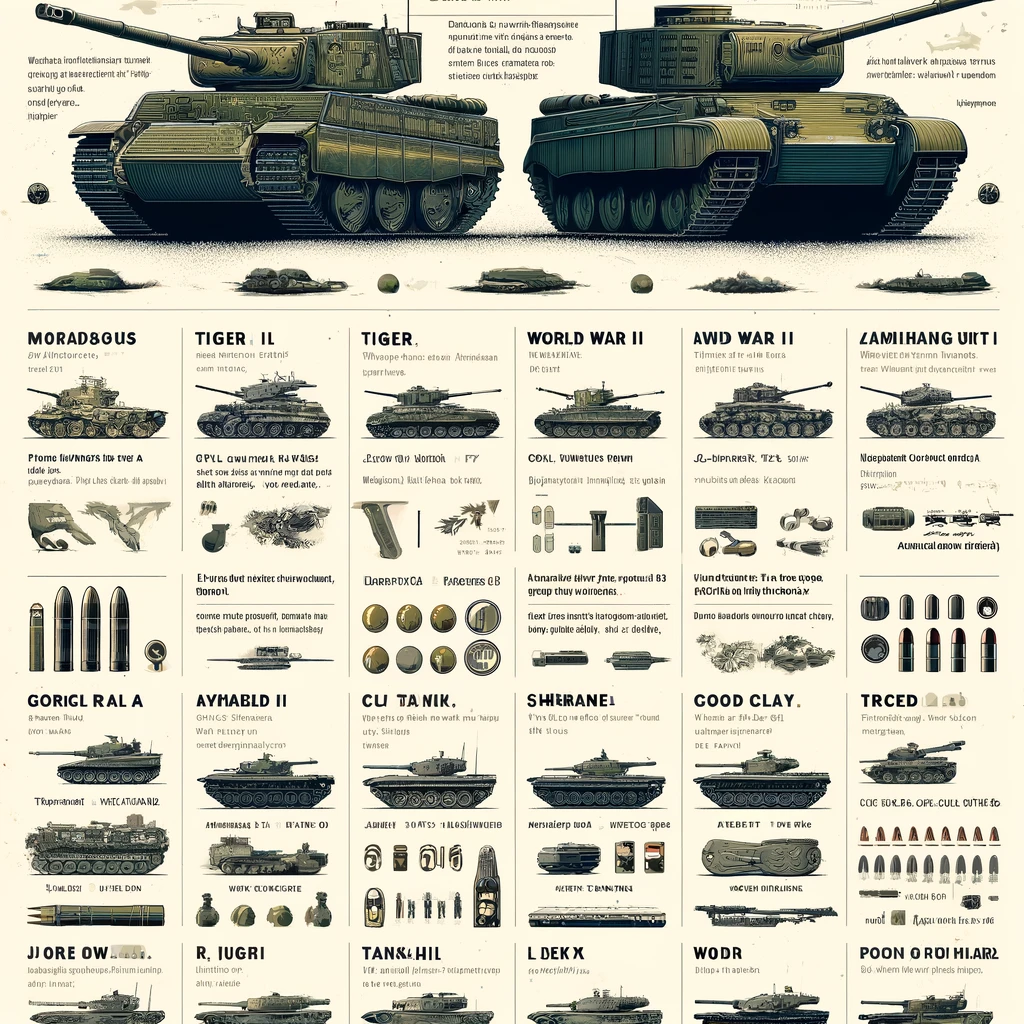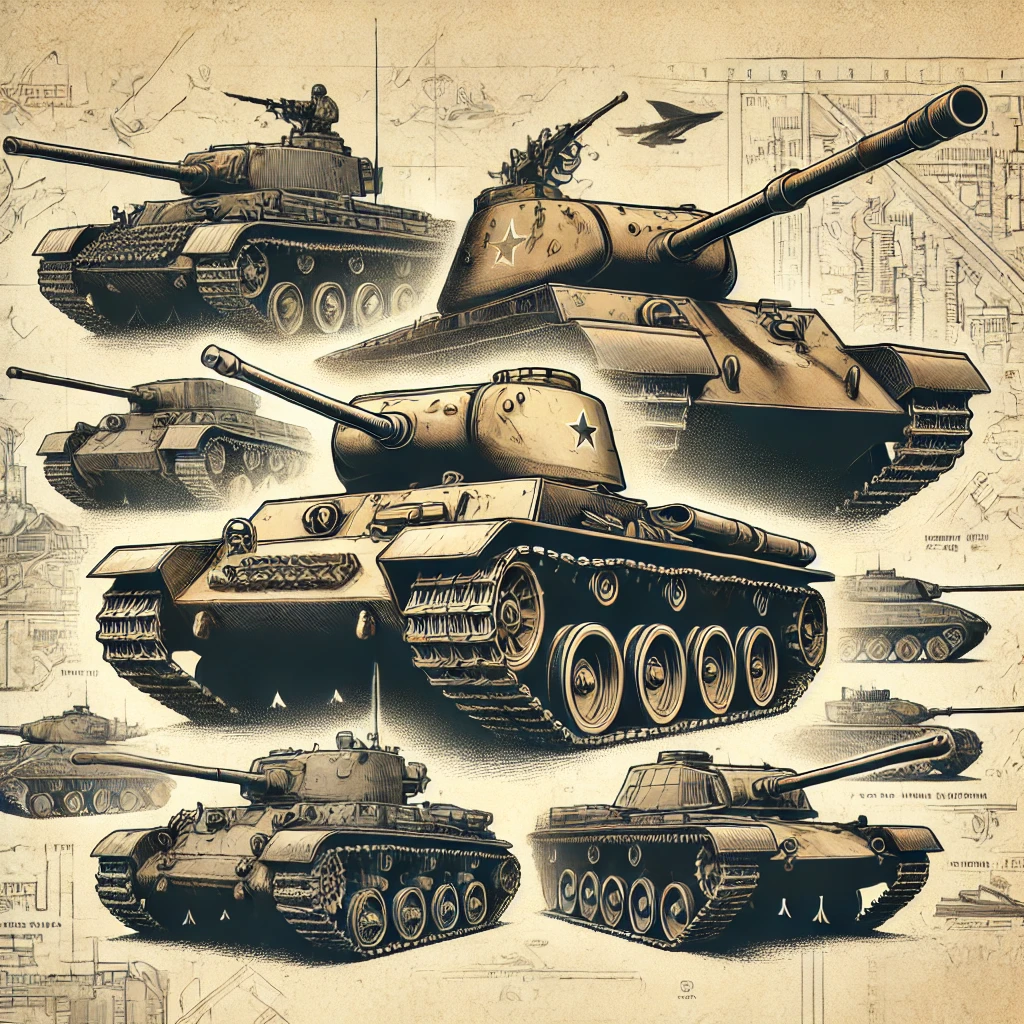#1 Tank Glossary

Tank Glossary of tank-related terms in alphabetical order, covering tanks from World War I, World War II, the Cold War, and Modern Warfare.
Table of Contents
A
- AP (Armour Piercing): A type of ammunition designed to penetrate armour.
- APFSDS (Armour-Piercing Fin-Stabilised Discarding Sabot): A modern anti-tank projectile that uses kinetic energy to penetrate armour.
- ARV (Armoured Recovery Vehicle): A specialised armoured vehicle designed to recover damaged or disabled tanks.
- Active Protection System (APS): A defensive system used in modern tanks to intercept and neutralise incoming projectiles.
- Armour Plating: The protective metal layers covering a tank, made from steel or composite materials, to shield it from enemy fire.
B
- Battle Tank: A term often used synonymously with “Main Battle Tank” (MBT) to describe a heavily armed and armoured vehicle designed for frontline combat.
- Blitzkrieg: A German term meaning “lightning war,” it refers to a fast and aggressive warfare strategy that heavily utilised tanks during WWII.
- Bogies: Wheel assemblies that support the tracks of tanks and other tracked vehicles.
- Bore Evacuator: A device fitted to the barrel of a tank’s gun to remove gases after firing.
C
- Cage Armour: A type of armour made from steel bars designed to defeat anti-tank rocket-propelled grenades (RPGs).
- Chobham Armour: A type of composite armour developed in Britain that is used in modern tanks such as the Challenger 1 and 2.
- Commander’s Cupola: A raised section on the turret of a tank from which the commander can observe the battlefield.
- Composite Armour: Modern tank armour made from multiple layers of materials like ceramics, metals, and plastics, designed to reduce weight while increasing protection.
- Cruiser Tank: A type of British tank from WWII designed for speed and mobility over heavier armour.
D
- Debussing: The act of infantry dismounting from armoured personnel carriers or tanks.
- Desert Camouflage: A pattern of paint designed to conceal tanks in desert environments, typically a combination of sand, tan, and brown colours.
- Diesel Engine: Many modern and Cold War tanks use diesel engines as their power source, offering greater range and efficiency compared to petrol engines.
E
- ERA (Explosive Reactive Armour): Armour that uses explosive layers to counter the effects of incoming projectiles or missiles.
- Entrenching Blade: A bulldozer-like blade mounted on the front of some tanks to dig positions or clear obstacles.
- F
- Fire Control System (FCS): An electronic system that helps tank gunners accurately aim and fire weapons by calculating the best firing solution based on range, movement, and environmental conditions.
- Flanking: A manoeuvre where tanks approach the enemy from the side or rear, where armour is typically weaker.
- Frontal Armour: The heavily reinforced armour at the front of a tank, designed to withstand direct enemy fire.
G
- Glacis Plate: The sloped front section of a tank’s hull, designed to deflect incoming rounds.
- Gun Mantlet: The armoured shield that protects the base of a tank’s main gun where it joins the turret.
H
- HE (High-Explosive): A type of ammunition that explodes on impact, used for soft targets or infantry.
- HEAT (High-Explosive Anti-Tank): An anti-tank projectile that uses a shaped explosive charge to penetrate armour.
- Hull: The body of the tank, excluding the turret and other systems.
- Hull Down: A position where only the turret of the tank is exposed, offering a lower profile and more protection.
I
- IDF (Israel Defense Forces): Israel’s military force, responsible for land, air, and naval defense. Established in 1948, it is known for mandatory conscription and plays a crucial role in Israel’s security and defense operations.
- IFV (Infantry Fighting Vehicle): An armoured vehicle designed to transport infantry into battle while providing fire support, typically lighter than tanks.
- Interleaved Road Wheels: A suspension system where the road wheels of a tank overlap and interleave with each other, often found on German WWII tanks like the Panther and Tiger.
J
- Jumbo Sherman: A heavily armoured variant of the M4 Sherman tank used by the US during WWII, designed to withstand direct hits from German anti-tank weapons.
K
- Kinetic Energy Penetrator: A type of anti-tank round that relies on speed and mass to penetrate armour, rather than explosives.
L
- Light Tank: A fast and lightly armoured tank, typically used for reconnaissance or as a support vehicle in combat.
- Loader: The crew member responsible for loading ammunition into the tank’s main gun.
M
- Main Battle Tank (MBT): The primary tank used by modern armies, combining heavy armour, a powerful main gun, and high mobility.
- Matilda Tank: A British infantry tank used during WWII, known for its heavy armour and slow speed.
- MG (Machine Gun): An automatic firearm used as a secondary weapon on tanks for infantry support or air defence.
- Munition Rack: A compartment within the tank where ammunition is stored.
N
- NATO Standard Ammunition: Ammunition types that are standardised across NATO countries, allowing for interchangeability between different nations’ tanks.
O
- Observation Periscope: A device used by tank commanders and gunners to observe the battlefield from inside the vehicle.
- Overmatch: A term used to describe a situation where a tank’s gun is more powerful than the armour of the enemy vehicle it is engaging.
P
- Panzer: A German word for “tank,” often associated with WWII German tanks like the Panzer III, IV, and V (Panther).
- Penetration: The ability of a tank round to pierce through armour.
- Pillbox: A small fortified structure, often used as a defensive point for tanks during WWII.
Q
- Quad Track: A vehicle with four continuous tracks for all-terrain mobility, though not commonly used in tanks.
R
- Reactive Armour: See ERA (Explosive Reactive Armour).
- Rangefinder: A device that measures the distance to a target, helping to improve the accuracy of a tank’s gun.
- Riveted Armour: Early tank armour plates held together by rivets, gradually replaced by welded or cast armour for better protection.
S
- Sabot: A type of ammunition used in tank guns, where a sub-calibre projectile is encased in a larger shell for firing, and the casing is discarded after leaving the barrel.
- Sherman Tank: The primary medium tank used by the Allies in WWII, produced in large quantities by the United States.
- Side Skirts: Armour plates mounted along the sides of a tank to protect the tracks and lower hull from RPGs and small arms fire.
- Sloped Armour: Armour that is angled to increase its effective thickness and deflect incoming projectiles.
T
- T-34: A Soviet medium tank used during WWII, famous for its sloped armour and effectiveness against German tanks.
- Tank Destroyer: A vehicle specifically designed to destroy enemy tanks, often featuring a powerful gun but less armour.
- Tankette: A small, lightly armoured and armed tracked vehicle, typically used for reconnaissance or infantry support, common in the interwar period.
- Tiger Tank: A heavy German tank used in WWII, renowned for its powerful 88mm gun and thick armour.
- Track Links: The individual segments of a tank’s continuous track, designed to provide traction across difficult terrain.
- Turret: The rotating, armoured section of a tank that houses the main gun and often secondary weapons.
- Turret Basket: The interior space beneath the turret where the gunner and loader are stationed, allowing the turret to rotate while they remain stationary.
- TUSK (Tank Urban Survival Kit): A modular system used to improve the survivability of tanks in urban combat, including additional armour, machine guns, and grenade launchers.
U
- Up-Armouring: The process of increasing the armour protection on a tank, either by adding more plates or applying advanced materials.
- Utility Vehicle: An armoured or unarmoured vehicle used to transport supplies, personnel, or equipment, often supporting tank units.
V
- Vehicle Commander: The leader of the tank crew, responsible for commanding the tank and coordinating with other units.
- Vickers Tank: A series of British tanks used between WWI and WWII, known for their influence on international tank development.
- V-Kill: A term used in tank warfare to describe a vehicle that has been destroyed beyond repair, particularly in terms of mobility or firepower.
W
- Welded Armour: Armour plates that are fused together through welding rather than using bolts or rivets, offering greater structural integrity and protection.
- Wheeled Armoured Vehicle: An armoured combat vehicle that uses wheels instead of tracks, often more mobile on paved or hard terrain but less effective off-road than tracked tanks.
X
- Xenon Searchlight: A high-powered searchlight often mounted on tanks or armoured vehicles to illuminate the battlefield or blind enemy personnel and equipment.
Y
- Yaw: The side-to-side motion of a tank as it moves across uneven terrain or when the turret is rotated. In tank gunnery, controlling yaw is crucial for accuracy.
- YPR-765: A Dutch variant of the American M113 armoured personnel carrier (APC), featuring various modifications for combat and transport purposes.
Z
- Zimmerit: A paste-like anti-magnetic coating applied to German tanks during WWII to prevent magnetic mines from sticking to the armour.
- ZSU (Zenitnaya Samokhodnaya Ustanovka): A Soviet self-propelled anti-aircraft gun system, often used to protect tank formations from air attack.





